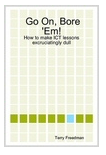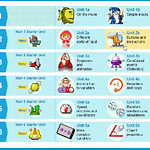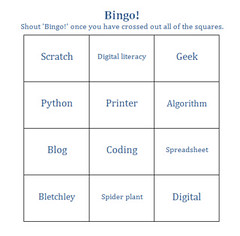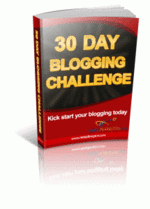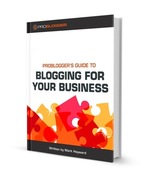Is writing an online review any different from writing an offline one? Probably the biggest difference is the (usual) restriction on word count. Most good website articles weigh in at around 500 words. Occasionally -- very occasionally -- I expand beyond that, but a good rule of thumb is that anything over 1,000 words or so could probably benefit from being split into two or more posts.
Strange that, when you come to think of it. You'd think that, given what is effectively an infinite amount of space, a website could cope with a few essays now and again.
Of course, the key factor is not the amount of room you have, but the supposed antipathy of readers towards scrolling. "Keep it above the line!", advertisers demand. That is, make sure the viewer doesn't have to scroll down in order to see it. So the same goes, or so the common wisdom has it, for any copy appearing on a computer screen.
In fact, restricting your prose to above the line (or fold, as it's also known) is not only an impossible exercise (how do you know how big your readers' screens will be, or how large they like their text?) but a pointless one. As Jacob Neilsen points out, people are quite happy to scroll down these days, although given people's relatively short attention span when reading text on a screen, it's probably better to err on the short side, given a choice.
Now, the reason that I've gone into some detail on this apparently minor point is that I think it's important to give people reasons for doing something, or not doing it, and this is where I think How to Write an Online Review falls down. It gives short, sharp advice, without really explaining the reasoning behind it, or leaving any room for discussion.
And there is room for discussion. You might want to question not only the scrolling argument, but even the attention span argument. For example, if I invite you to write a review of a software application, which would cost a school several hundred dollars to implement, I'd expect more than a cursory 500 words, unless the product is such a pig that it's not worth wasting any words on it. (I'm reminded of Dorothy Parker's review of a book: "This is not a book to be tossed aside lightly. It should be thrown with great force.") More importantly, my readers would want you to go into some depth. After all, if they think it's too long they'll vote with their mice; but you ought to give them that choice.
So the "rule" about keeping the review to "500 words or less" -- it should actually be "fewer": why does a video about writing contain such an error? -- is not a rule at all. It is a point to be discussed with an editor (which may be yourself, if you're writing for your own website or blog), taking into account the nature of your audience.
If you don't know how your readers feel about long articles, then you need to ask them, or find out in some other way. In other words, you need to do research, and act accordingly. Where will you do your research? Well, apart from reading articles on the subject, you could also analyse your web statistics. How long are people spending on your website? How long are they spending on each page, on average? Which posts are the most popular? How are they different from the rest? (Google Analytics is a great tool for answering the quantitative questions.)
Already, we have taken this apparently simple task of writing a review from a kind of painting-by-numbers approach which, frankly, has no, if any value, as far as the ICT curriculum is concerned, to one that starts to address Levels 4 or 5 (audience), and even nudge up to the higher levels (customer feedback). The temptation to use a video like this straight off the bat without really thinking about it is great indeed. But that's like buying something in a supermarket because it's on special offer, not because you will actually use it.
There's another curious bit of advice in the video: use strong verbs and nouns. What's a strong noun? What's a strong verb, come to that? Surely it would be better to use the most appropriate word? I may be wrong, but without having been given an explanation of the word "strong" in this context, how can I know?
One useful piece of advice is to use the active rather than the passive tense. This is always the right thing to do unless you are writing an academic article or your objective is to bore the reader into a stupor. Saying something like, "I drew the picture and then coloured it in using the Fill tool" is much more dynamic, and therefore engaging, than the passive (almost supine) "The picture was drawn by the reviewer ,etc etc".
What about the advice that was left out? For example:
- Discussing with the website editor or blog owner exactly what his or her requirements are.
- Should screenshots be included?
- What rights are you giving away?
- Must the review be brand new, or is it OK to recycle one you wrote before?
- If you live in the UK, such are our libel laws that it's probably a good idea to be on the safe side and make sure you include the magic mantra, "In my opinion" in the review if you've decided to pan it.
Incidentally, everything I've written here is only my opinion, which I formed whilst watching and reflecting on the Howcast video (see below).
So am I saying this video is a waste of time and that you shouldn't show it? Not at all. By all means, use it as a starting point for discussion with your class, and use it (or its best points) as an aide-memoir once you've covered the topic.
In fact, once you've decided to not use it straight out of the box, but to encourage discussion and questioning around it, you'll probably conclude that it's not really a bad piece of video at all.
 "Erm, tell me, Terry. How do you actually earn money?" This is a question that I am constantly asked because, I think, I don't do a lot of self-promotion as far as drumming up work is concerned. I've tended to rely on word of mouth referrals, but in order to pre-empt the question I quoted at the start of this paragraph, and because I think I ought to be a bit more overt in my approach, I thought I'd write some articles about what I do for a living.
"Erm, tell me, Terry. How do you actually earn money?" This is a question that I am constantly asked because, I think, I don't do a lot of self-promotion as far as drumming up work is concerned. I've tended to rely on word of mouth referrals, but in order to pre-empt the question I quoted at the start of this paragraph, and because I think I ought to be a bit more overt in my approach, I thought I'd write some articles about what I do for a living. "Erm, tell me, Terry. How do you actually earn money?" This is a question that I am constantly asked because, I think, I don't do a lot of self-promotion as far as drumming up work is concerned. I've tended to rely on word of mouth referrals, but in order to pre-empt the question I quoted at the start of this paragraph, and because I think I ought to be a bit more overt in my approach, I thought I'd write some articles about what I do for a living.
"Erm, tell me, Terry. How do you actually earn money?" This is a question that I am constantly asked because, I think, I don't do a lot of self-promotion as far as drumming up work is concerned. I've tended to rely on word of mouth referrals, but in order to pre-empt the question I quoted at the start of this paragraph, and because I think I ought to be a bit more overt in my approach, I thought I'd write some articles about what I do for a living.
